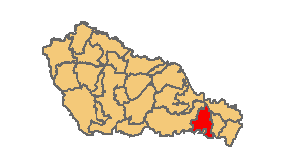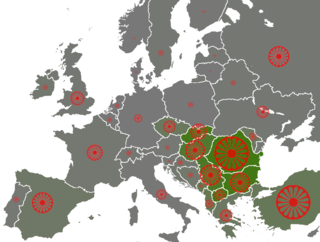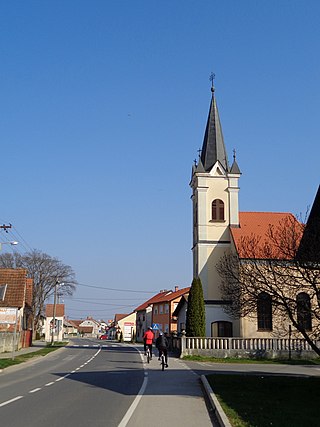
The demographic characteristics of the population of Croatia are known through censuses, normally conducted in ten-year intervals and analysed by various statistical bureaus since the 1850s. The Croatian Bureau of Statistics has performed this task since the 1990s. The latest census in Croatia was performed in autumn of 2021. According to final results published on 22 September 2022 the permanent population of Croatia at the 2021 census had reached 3.87 million. The population density is 68.7 inhabitants per square kilometre, and the overall life expectancy in Croatia at birth was 78,2 years in 2018. The population rose steadily from 2.1 million in 1857 until 1991, when it peaked at 4.7 million. Since 1991, Croatia's death rate has continuously exceeded its birth rate; the natural growth rate of the population is negative. Croatia is in the fourth stage of the demographic transition. In terms of age structure, the population is dominated by the 15 to 64 year‑old segment. The median age of the population is 43.4, and the gender ratio of the total population is 0.93 males per 1 female.
Boyash or Bayash refers to a Romani ethnic group living in Romania, southern Hungary, northeastern and northwestern Croatia, western Vojvodina, Slovakia, the Balkans, but also in the Americas. Alternative names are Rudari (Ludari), Lingurari and Zlătari.

Roma, traditionally Țigani, constitute one of Romania's largest minorities. According to the 2011 census, their number was 621,573 people or 3.3% of the total population, being the second-largest ethnic minority in Romania after Hungarians. There are different estimates about the size of the total population of people with Romani ancestry in Romania, varying from 4.6 per cent to over 10 percent of the population, because many people of Romani descent do not declare themselves Roma. For example, in 2007 the Council of Europe estimated that approximately 1.85 million Roma lived in Romania, based on an average between the lowest estimate and the highest estimate available at the time. This figure is equivalent to 8.32% of the population.

Croatia is a predominantly Christian country, with Islam being a minority faith. It is followed by 1.3% of the country's population according to the 2021 census. Islam was first introduced to Croatia by the Ottoman Empire during the Croatian–Ottoman Wars that lasted from the 15th to 16th century. During this period some parts of the Croatian Kingdom were occupied which resulted in some Croats converting to Islam, some after being taken prisoners of war, some through the devşirme system. Nonetheless, Austria strongly fought against the Turks during these few centuries which resulted in the fact that the westernmost border of the Ottoman Empire in Europe became entrenched on the Croatian soil. In 1519, Croatia was called the Antemurale Christianitatis by Pope Leo X in one letter, as well as Poland, Armenia or Albanians.

Orehovica is a village and municipality in Međimurje County, Croatia. There are three villages in the municipality – Orehovica, Podbrest and Vularija.

Mala Subotica is a village and municipality in Međimurje County, Croatia.

Selnica is a village and municipality in Međimurje County, in northern Croatia.

Sveta Marija is a village and a municipality in Međimurje County, Croatia. It is located in the south-eastern part of the county, near the Drava River, approximately 27 kilometres south-east of Čakovec and 11 kilometres east of Prelog, the largest and second-largest city of Međimurje County respectively.

The languages spoken in Hungary include Hungarian, recognized minority languages, and other languages.

The Romani people have several distinct populations, the largest being the Roma and the Calé, who reached Anatolia and the Balkans in the early 12th century, from a migration out of the Indian subcontinent beginning about 1st century – 2nd century AD. They settled in the areas of present-day Turkey, Greece, Serbia, Romania, Croatia, Moldova, Bulgaria, North Macedonia, Hungary, Albania, Kosovo, Bosnia and Herzegovina, Czech Republic, Slovenia and Slovakia, by order of volume, and Spain. From the Balkans, they migrated throughout Europe and, in the nineteenth and later centuries, to the Americas. The Roma population in the United States is estimated at more than one million.
Romani people, or Roma, are the fourth largest ethnic group in Serbia, numbering 131,936 (1.98%) according to the 2022 census. However, due to a legacy of poor birth registration and some other factors, this official number is likely underestimated. Estimates that correct for undercounting suggest that Serbia is one of countries with the most significant populations of Roma people in Europe at 250,000-500,000. Anywhere between 46,000 to 97,000 Roma are internally displaced from Kosovo after 1999.

Romani people in North Macedonia are one of the constitutional peoples of the country.

Pribislavec is a village and municipality in Međimurje County, in northern Croatia.

Hungarians are a recognized ethnic minority in Croatia. According to the 2011 census there are 14,048 people of Hungarian ethnicity living in Croatia. Around two thirds of them (8,249) live in Osijek-Baranja County in eastern Croatia, especially in the Croatian part of the Baranya region which borders Hungary to the north. There are also small Hungarian communities in other parts of the country, including areas in Bjelovar-Bilogora County in central Croatia where 881 people identify themselves as Hungarian.

Bosniaks of Croatia are one of the ethnic minorities of the Republic of Croatia. According to the 2021 Croatian census, there were 24,131 Bosniaks, or 0.62% of the total population, making them the third largest ethnic group in the country after Croats and Serbs.
The Albanians of Croatia are people of full or partial Albanian ancestry and heritage who are an ethnic minority in Croatia.

Romani people in Germany are estimated to around 170,000-300,000, constituting around 0.2-0.4% of the population. One-third of Germany Romani belong to the Sinti group. Most speak German or Sinte Romani.

The Constitution of Croatia in its preamble defines Croatia as a nation state of ethnic Croats, a country of traditionally present communities that the constitution recognizes as national minorities and a country of all its citizens. National minorities explicitly enumerated and recognized in the Constitution are Serbs, Czechs, Slovaks, Italians, Hungarians, Jews, Germans, Austrians, Ukrainians, Rusyns, Bosniaks, Slovenes, Montenegrins, Macedonians, Russians, Bulgarians, Poles, Romani, Romanians, Istro-Romanians ("Vlachs"), Turks and Albanians. Article 12 of the constitution states that the official language in Croatia is Croatian, but also states that in some local governments another language and Cyrillic or some other script can be introduced in official use.

The Croatian Romani Union "Kali Sara" is an political and self-government organization of the Romani people in Croatia. Its seat is located in Croatian capital city of Zagreb.
World Day of Romani Language promotes Romani language, culture and education. It is celebrated annually on 5 November, since 2009. Croatian Parliament officially recognized it in 2012 and UNESCO proclaimed 5 November the World Day of Romani Language in 2015. As of 2018, 16 Council of Europe member states recognize Romani language as a minority language under the European Charter for Regional or Minority Languages.















